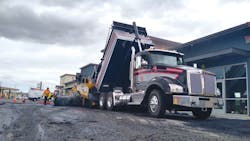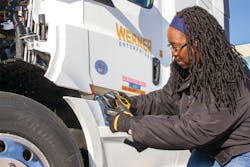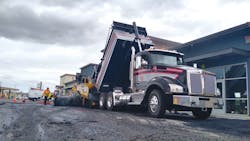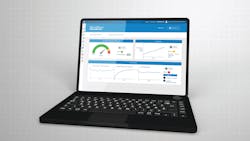For 15 years, Danny Lilley, vice president of fleet systems and technology for Werner Enterprises, has been something of a trucking data whisperer, one of those left-brained financial whizzes who can shake a clump of data until a bunch of money falls out.
Previously, during his 11-year tenure at Swift Transportation, Lilley instituted changes to the fleet’s warranty process to recover $700,000 annually and managed the life cycle of 70,000 assets (15,000 trucks and 55,000 trailers). He also worked with a third-party developer to create a custom telematics platform that brought light to a problem fleets had long oversimplified to the detriment of their bottom line.
“From an equipment buying standpoint, we had always gone with the cheapest truck,” Lilley recalled. “We never looked at the total cost of ownership.”
Before the age of modernization, it was far too easy for trucking companies to become ensnared by this mental trap of oversimplification. The foundation of this premise—cheaper equipment equals more profits—appeared innocuous enough, but over time, as more sensors were added and more information made available, the value proposition of looking deeper into the data and not the sticker price revealed itself.
“Yes, this truck is cheaper, but it breaks down more and the fuel economy is less, so in the long run, it costs you thousands of dollars more, and the resale value at the end is substantially less,” Lilley said.
This was because original equipment manufacturers (OEMs) and suppliers made great strides in engineering smarter, more efficient components, from the front grille to the trailer doors and everything in between. For example, because of engine innovations and increased fuel economy, Fleet Advantage found that replacing a 2012 model year Class 8 sleeper truck for a 2019 version yielded a first-year savings of $26,687, according to its 2018 Truck Lifecycle Data Index.
Swapping to newer equipment and trucks is only the beginning, though. The next wave of economic epiphanies is flooding in from data lakes overflowing with actionable insights. The sheer volume of potential positive changes a determined fleet manager can make based on the real-time equipment health and fault codes should have lean trucking advocates geeking out. The same goes for those who just get by with moderate spreadsheet skills. Because in 2020, leveraging equipment data is no longer a luxury; it is crucial to successfully powering your fleet into the rest of the decade.”
‘Edge’ computing
Since joining Werner in late 2017, Lilley’s analytical talents have been integral to the development of the recently launched Werner EDGE, an untethered tablet-based telematics solution that links the truck data to drivers, shippers and carriers to make changes when necessary. It centralizes and consolidates third-party vendor information to bridge the gap between the front-end telematics side and the back end. The Critical Event Management function focuses on safety-related data and coachable moments, while the Breakdown Management feature expedites the repair process in the event of a roadside breakdown.
“What we’ve seen there from our road breakdown crew is about a 26% increase in productivity since that solution has been rolled out,” Lilley said of the custom-built solution, which analyzes fault codes and other factors to quickly diagnose issues and cut average repair order process time by 40%.
Since testing began in January, Lilley noticed “a substantial improvement not only in productivity, but in driver dwell time and getting [drivers] back on the road faster.”
Channeling disparate streams of data, such as from outward-facing cameras, the engine, and the braking system, and pouring them into the same pool has also proven effective. Werner had been reviewing and coaching 3,000 separate video events and 3,000 telematics events, respectively. Lilley said there was 100% overlap, cutting the actual number of events by 50%.
Linking the two also provided a more precise view of the event. “Let’s say someone swerved in front of our vehicle, that would activate that critical event system if the driver slammed on their brakes,” Lilley explained. “We have a video of what happened and the truck’s speed and rpm. So there’s telematics data that supports the analysis of what actually happened.”
The fleet can then go to drivers and coach them on where behavior can be improved.
“Something as simple as how often in top gear do you use cruise control is just a very basic metric that could improve safety and fuel economy,” Lilley said. “That’s good telematics data that is very actionable.”
The data isn’t only used as a “gotcha” to catch inefficient or unsafe driving. “If we see something a driver is doing well, we can have a positive conversation,” Lilley added.
Vocational calling
Regarding telematics data utilization, while vehicle efficiency, such as improving mpg, is certainly a critical component, many fleets would argue uptime and asset utilization are more important than efficiency, regardless of segment.
When asphalt hits the bed of one of DeSilva Gates Construction’s Kenworth T880s, the clock starts ticking. The material doesn’t stay good forever, noted the infrastructure building company’s chief superintendent, Rich Poppoff, so “time is of the essence.”
“When we can’t get that truck empty, we’re looking at 20 tons of junk,” Poppoff said. “And with asphalt north of $100 a ton right now, that’s a lot of money to throw away, not to mention the paving crews now stop, everything stops—over one truck.”
That’s simply not tenable, considering there could be a parade of excavators, loaders and other trucks waiting to do their part of building a new airport or residential development. In 2019, DeSilva integrated all its assets, including 125 T880s, along with various Caterpillar and John Deere equipment, into Samsara’s fleet management platform.
Unlike in the past where a truck system issue would trigger a “check engine” light, Poppoff explained the telematics system now provides a fault code to the driver and the fleet while also prioritizing the severity of the issue. Critical alert notifications, such as for oil pressure or overheating, are sent directly to supervisors’ smart devices.
“When the guy calls in, we just look up his truck, and it tells you what the code is right then and there,” Poppoff said. “We can tell him whether he’s safe to drive or whether he needs to pull over or go to a Kenworth [dealership] right away. It has really cut down on our troubleshooting time.”
And because the fleet is better informed to the true nature of a truck’s “illness” and can make operational and maintenance decisions based off the sensor data, Poppoff noted vehicle utilization has increased by 10%.
This data kept in the work order system also allows DeSilva to identify trends and recurring issues. That process of collecting all the events and gathering files as evidence to send to the OEM is no longer as labor intensive, with months of analyzing cut to mere minutes, Poppoff said. Replacing manual spreadsheets for the digital system has also cut about eight administrative work hours per week.
Filter monitoring innovations
Engine and transmission manufacturers have leveraged data for several years to diagnose problems, prioritize repairs, and optimize operations. Fleets are also leveraging sensor and camera data to inform advanced driver assistance systems (ADAS) for collision mitigation, adaptive cruise control, and lane-departure alerts. It has now gotten to the point that even oft-overlooked parts are getting in on the actionable data. These, too, play an important role in the pursuit of better total cost of ownership (TCO) and higher uptime.
Donaldson, which provides heavy-duty air filters, had its own innovation to reveal at the North American Commercial Vehicle Show in 2019. Through a partnership with telematics provider Geotab, Donaldson had begun testing its Filter Minder wireless monitoring system on heavy-duty engines via a wireless pressure sensor. The data from each asset equipped with the device is accessible on the MyGeotab platform dashboard. The result is increased filter visibility and another way to improve overall efficiency.
“As we get more and more data, we’ve been validating that there are a lot of opportunities for fleets to save money by optimizing when to actually perform service,” said Nate Zambon, director of the Filter Minder division of Donaldson, which he acknowledged can be a “fairly costly service.”
He offered a recent example of a fleet piloting the technology as a biannual preventive maintenance practice. Zambon said the fleet ended up registering a filter it changed as having 95% life left and asked Donaldson to check the gauge. The raw data showed, in fact, the filter had 95% life left and did not require the service.
As soon as late summer, Donaldson will begin an early adopter program for sensing liquid data, including for oil, hydraulic and fuel filters. This would provide valuable insights into engine oil service intervals, Zambon said, providing insights into the degradation rate of the “engine’s lifeblood.” It would also eliminate the need to determine service intervals off mileage.
He doesn’t think a fleet will try to “optimize to the Nth degree” and determine air filter changes solely based on percentage of life left. Instead, he said fleets will likely take a more holistic look at their entire service interval approach to get as much done during a dealership visit, but not more than they need.
This feature could prevent engine failure, too.
“If an injector goes bad, you can start spraying a bunch of excessive oil. That can dilute the oil and you can lose all the lubrication characteristics,” Zambon theorized. “Potentially, you can wreck the entire engine and spend $40,000 instead of $2,000 on an injector repair.”
Cold comfort
“More than ever before, [customers] want to see a lot of their operational efficiencies,” said Rodrigo Castro, strategic account manager for telematics at Thermo King.
That is why Thermo King acquired telematics provider Celtrak in 2015. The companies had partnered on the refrigerated transport provider’s TracKing platform, which gives the cold supply chain a better indication of perishable goods temperature and location data. It also provides alarm codes for when the environment is compromised, or will be, due to equipment failure.
Currently, those three parameters are what is required by the Food Safety Modernization Act enacted in 2011, but Castro said new emissions regulations will require reefer fleets “to step up the maturity level required in telematics.” This includes knowing who should receive what data. Maintenance might want alert history, while quality control cares more about the temperature in certain zones or information needed to run reports.
The best prevention against a trailer full of spoiled beef could be that of sending a simple text alert to the right person. “I do a lot of training with fleets, and I first make sure that they understand 100% how to set up their refrigeration unit so when it goes out of [temperature] range, someone within the fleet is notified,” Castro said. “That’s the best tool to avoid load loss.”
This played out during the height of the COVID-19 pandemic when a fresh load of strawberries was not reaching the proper temperature. Thermo King’s service department, working in concert with the dealer, accessed the telematics web portal and remotely changed the unit setting from continuous to “auto-start-stop.”
“This allowed the unit to run in high speed, pull down, and get to a set point to save the load,” Castro said. “We do little quirks like that every day through our dealer network to try to minimize downtime and to minimize speculation within a fleet.”
As with other telematics solutions, Thermo King is working to become more predictive. Castro said the goal is to use data points such as average engine run time and the history of alarm codes and feed that data into an algorithm. The end goal is to tell fleets the risk of a reefer unit shutting off and what to do to keep that from happening, be it replacing a fan or coil.
This third wave of predictive telematics is already being talked about as a standard feature on Nikola’s battery electric and fuel cell electric trucks projected to launch in the next few years. Daimler Trucks of North America and other OEMs are reportedly in early stages, though getting all the various parts made by various equipment vendors to communicate efficiently has proven a challenge.
So, what does Lilley have to say about the future?
“As I look at the next few years, we want to identify failures before they happen, and then work with OEs to actually cover those failures under warranty,” he said. “It’s one thing to identify an alternator that’s about to go out, but I can’t replace that until there’s actually warranty coverage. I think that will be really important, and that will allow us to keep the trucks on the road.”
About the Author
John Hitch
Editor
John Hitch is the editor-in-chief of Fleet Maintenance, providing maintenance management and technicians with the the latest information on the tools and strategies to keep their fleets' commercial vehicles moving. He is based out of Cleveland, Ohio, and was previously senior editor for FleetOwner. He previously wrote about manufacturing and advanced technology for IndustryWeek and New Equipment Digest.





